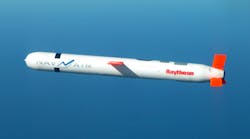Since the 1980s, the US Navy has been using Tomahawk missiles for long-range precision-strike missions. Thanks to recent upgrades to the electronic-support-measure (ESM) system, it will soon be able to track moving targets as well. With a range of approximately 1000 statute miles, the Tomahawk Block IV missile is a surface- and submarine-launched precision-strike stand-off weapon. Over 2000 have been employed in combat.
This file type includes high resolution graphics and schematics when applicable.
Recently, Raytheon completed field tests of an advanced ESM seeker to be installed as part of the improvement program. That seeker incorporates a next-generation processor and antenna, which are capable of locating and tracking both fixed and moving targets by following their electromagnetic (EM) signature. It also can track multiple targets at once, although the specific number is classified. A wideband conformal array consisting of 16 antennas is utilized— each providing broad frequency coverage and angular direction finding for the active-radar-homing (ARH) solution. The antenna also boasts conformal receive elements and high-precision angular DF accuracy.
In addition, the upgrade includes a two-way satellite data-link, enabling a strike controller to redirect the missile in-flight to preprogrammed alternate targets or more critical targets. The seeker uses an ultra-high-frequency (UHF) satellite-communications (satcom) system, which is carried by the DoD UHF Follow On System. That sitcom system provides two-way data communications including in-flight health and status and mission or target re-assignments. The satcom system is set to be enhanced over the Tomahawk’s re-certification and re-manufacture program from 2017 to 2019.
In the field tests, the seeker was validated in a realistic, high-density environment after seven months of testing in anechoic chambers. Using a high-power processor, the passive sensor successfully identified a target with accurate direction finding and location. A captive flight test of the technology is scheduled for December/January 2013. An added active RF channel is planned for 2014. The multimode technology is expected to enable the Navy’s Surface Action Group to fire Tomahawks from sanctuary and defeat mobile threats at a long range.
This file type includes high resolution graphics and schematics when applicable.

